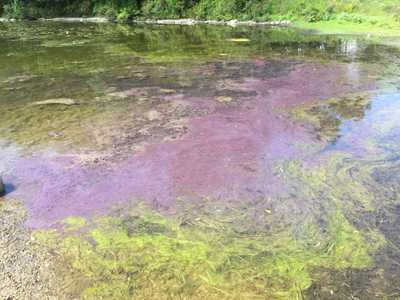CDC launches first national reporting system for harmful algal blooms and associated illnesses
New website provides information on how to help protect people and pets
This website is archived for historical purposes and is no longer being maintained or updated.
Media Advisory
For Immediate Release: Wednesday, June 22, 2016
Contact: CDC Media Relations
404-639-3286

Harmful algal bloom in a lake.
Photo credit: New York State Department of Health
What
CDC launched the first national reporting system for harmful algal blooms, as well as a new website with important information for health officials and the public. The One Health Harmful Algal Bloom System (OHHABS) will collect data on harmful algal blooms and associated human and animal illness. CDC encourages state and territorial public health agencies to use this voluntary system to report harmful algal blooms and associated illness. The new website provides information on how to recognize these blooms and what people can do to protect themselves, their families, and their pets.
Why
Evidence suggests that harmful algal blooms are increasing in frequency and severity as a result of climate change, farming practices, storm and wastewater runoff, and other environmental issues. Rapid growth of algae can create harmful blooms that produce toxins that get into the air, water, or food, or severely deplete oxygen in bodies of water. These blooms can harm animals, people, and the local ecology. OHHABS will help health officials understand the severity and extent of illnesses caused by harmful algal blooms in people and animals and the effect they have on the environment. This information will support efforts to prevent harmful algal blooms and the illnesses they cause.
Where
Information about OHHABS can be found at www.cdc.gov/habs/ohhabs.
CDC’s new webpage on harmful algal blooms can be found at www.cdc.gov/habs.
Background:
Toxins released by harmful algal blooms can cause a variety of illnesses in people or animals. Breathing in these toxins can cause coughing or respiratory problems, and swimming in water with a harmful algal bloom can cause skin rashes or other symptoms. People also can get sick from eating fish or shellfish or drinking tap water contaminated with the toxins.
Harmful algal blooms are considered a One Health issue. The One Health concept recognizes that the health of people is connected to the health of animals and the environment. More about One Health can be found here: http://www.cdc.gov/onehealth/.
- Page last reviewed: June 22, 2016 (archived document)
- Content source:



 ShareCompartir
ShareCompartir